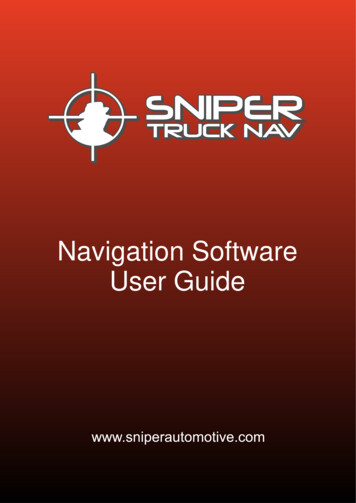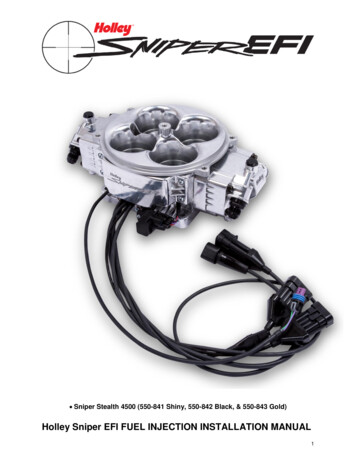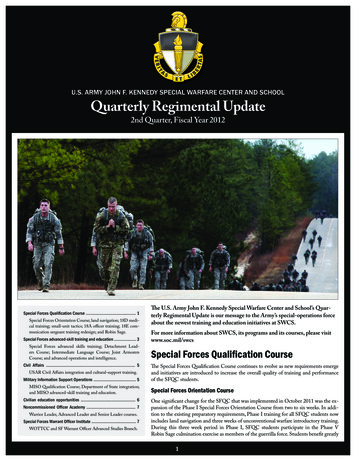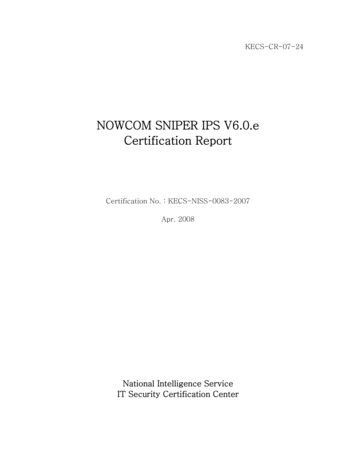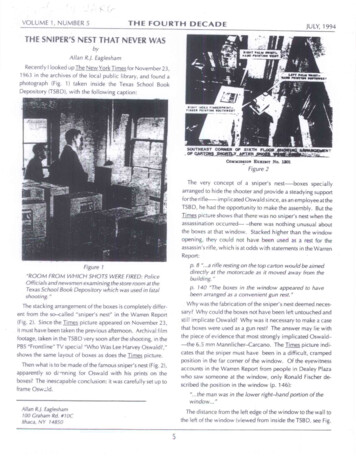
Transcription
THE FOURTH DECADEVOLUME 1, NUMBER 5JULY, 1994THE SNIPER'S NEST THAT NEVER WASbyAllan R.J. EagleshamRecently I looked up The New York Times for November 23,1963 in the archives of the local public library, and found aphotograph (Fig. 1) taken inside the Texas School BookLitr7 PALM PeitnT %ARO Polgrio. aorewoo.s,Depository (TSBD), with the following caption:RIGHT INDIA ItPOISONS*fumeSRTsounorgatSOUTHEAST CORNER Of SIXTH rLONIOf WiT.I.—SrilY—MIT-ICRJUINNUIPIMONTCow bamooN Exazarr No. 1201Figure 2The very concept of a sniper's nest—boxes speciallyarranged to hide the shooter and provide a steadying supportfor the rifle— implicated Oswald since, as an employee at theTSBD, he had the opportunity to make the assembly. But theTimes picture shows that there was no sniper's nest when theassassination occurred— –there was nothing unusual aboutthe boxes at that window. Stacked higher than the windowopening, they could not have been used as a rest for theassassin's rifle, which is at odds with statements in the WarrenReport:p. 8 ".a rifle resting on the top carton would be aimeddirectly at the motorcade as it moved away from thebuilding."Figure 1"ROOM FROM WHICH SHOTS WERE FIRED: PoliceOfficials and newsmen examining the store room at theTexas School Book Depository which was used in fatalshooting."p. 140 "The boxes in the window appeared to havebeen arranged as a convenient gun rest."Why was the fabrication of the sniper's nest deemed necessary? Why could the boxes not have been left untouched andThe stacking arrangement of the boxes is completely different from the so–called "sniper's nest" in the Warren Report(Fig. 2). Since the Times picture appeared on November 23,still implicate Oswald? Why was it necessary to make a casethat boxes were used as a gun rest? The answer may lie withit must have been taken the previous afternoon. Archival filmthe piece of evidence that most strongly implicated Oswald-the 6.5 mm Mannlicher–Carcano. The Times picture indicates that the sniper must have been in a difficult, crampedposition in the far corner of the window. Of the eyewitnessaccounts in the Warren Report from people in Dealey Plazafootage, taken in the TSBD very soon after the shooting, in thePBS "Frontline" TV special "Who Was Lee Harvey Oswald?,"shows the same layout of boxes as does the Times picture.Then what is to be made of the famous sniper's nest (Fig. 2),apparently so d? inningfor Oswald with his prints on thewho saw someone at the window, only Ronald Fischer described the position in the window (p. 146):boxes? The inescapable conclusion: it was carefully set up toframe Osw.Jd.".the man was in the lower right–hand portion of thewindow."Allan R.I. Eaglesham100 Graham Rd. #10CIthaca, NY 14850The distance from the left edge of the window to the wall tothe left of the window (viewed from inside the TSBD, see Fig.5
VOLUME 1, NUMBER 5THE FOURTH DECADEJULY, 1t1) is approximately 22 inches ll); perhaps it would be impossible, even for someone of Oswald's height and build, tocrouch in that corner and accurately fire the 38-inch-longCarcano. Without a substantial structure, such as stackedcartons of books, to provide mechanical support, perhaps itwould be beyond dispute that it was impossible to accuratelyfire the Carcano.Why did the assassin not arrange things to his advantage, sothat he had a comfortable position, using the boxes as support-by either raising the window, or lowering the boxes? Onepossibility is that his weapon was on a tripod that mostconveniently rested on the floor. Another is that the shooter'stime on the sixth floor was so tight as to preclude moving boxesbefore shooting. A third possibility is that he had, at all costs,to avoid being seen clearly from the street below, because hewas wearing a uniform for example.The Warren Report's long-winded verification that threespent shells had been expelled from Oswald's Carcano whileresting on the stacked boxes in the sniper's nest, now takes onnew meaning. Pages 555-556 of the Warren Report reads:".three expended cartridge cases were found.lyingbetween the south wall and a high stack of boxes whichran parallel to the wall. The cartridge cases were a shortdistance to the west of the southeast corner window inthat wall. in other words, the cartridge cases wereejected to the right of and a t roughly a right angle to therifle. The location of the cartridge cases was thereforeconsistent with the southeast window having beenused by the assassin, since if the assassin fired from thatwindow the ejected cartridges would have hit the pileof boxes at his back and ricocheted between the boxesand the wall until they came to rest to the west of thewindow."Figure 3Since there was no sniper's nest, the above can now beinterpreted as a description of how it was ascertained wherespent shells would come to rest when a Carcano was firedwhile resting on the boxes in Fig. 2. This little pantomime wasnecessary to determine the locatio:! r which "Oswald's" threeshell cases had to be planted.The box arrangement in the Times picture is consistent withwhat is seen in the Powell photograph (Fig. 3) of the TSBDexterior about a half-minute after the shooting. PhillipMelanson [2] has discussed some implications of the movement of the boxes at the window after exposure of the Dillardphotograph (Fig. 4), and before the Powell photograph wasFigure 4taken. In the Powell picture, the boxes in the left of thewindow (viewed from outside the TSBD) are pulled a fewcompared with the Dillard photograph. This movement ofinches back, and boxes on the right are pushed forward, asboxes during the half-minute immediately after the shoo6
THE FOURTH DECADEVOLUME 1, NUMBER 5JULY, 1994may denote a frantic search for expended cartridge cases.provide some insight into Lee Harvey Oswald's niche in thatCan readers help answer the question of why the Timespicture, with its profound implications, is not a widely knownsubject for discussion among people interested in the JFKsociety.assassination? Is the picture absent in most of the New YorkTimes editions that went out on the 23rd? If you have a copyin your possession, please check it and let me know what youIt was at Warren Easton Senior High School in New Orleansin the mid-1950s that I began to question the traditionalvalues. Not only did I abandon orthodox Christianity, but Isought to convert some of my classmates to Unitarianism,liberal religion, and Left politics. One young man whom I triedto persuade was a tall, handsome Texan. His girl friend, afind.devoted Baptist, grew alarmed when she heard my iconoclas-Notestic ideas. Distressed about my Leftist views, and hoping toprevent me from straying further— and worse, Tex Sanderspossibly straying with me—Mary lane arranged for me to1. Calculated from Commission Exhibit No. 887, WarrenReport p. 99, with reference to the measuring stick in the"sniper's nest" window shown in a photograph on p. 167 ofRobert I. Groden's The Ki II ing of a President (New York: Vikingdiscuss basic religious values with her father, who was anelder in a large, prominent New Orleans Baptist Church. Hehimself was well known, being a former acting SuperintendentStudio Books, 1993).2. Philip H. Melanson, "Stacking the Deck Against Oswald,"The Third Decade vol. 3 #4 May 1987, pp. 7-8.of the New Orleans Police Dept. and a former FBI agent.I went to Mary Jane's home and met with her father, GuyBanister. We spoke for only about two minutes. Clearly,reconverting me from Unitarianism was not high on his list ofpriorities.SURVEILLANCE STATE LOUISIANA COMING OF AGEIN NEW ORLEANS IN THE 1950s AND60sI remained a Unitarian. Moreover, I continued my Leftwarddrift and would remain on the Left until 1978. After highschool, I sought and received a scholarship to Tu lane University in New Orleans, where ROTC was not required as it wasbyat the state university. I became active in the peace movement, on racial issues, and even deemed myself a socialist. InHugh MurrayLong before Reagan's Presidency most Americans acceptedthe late 1950s I unofficially began attending a class at Dillardthe rhetoric of the Cold War: "the free world" vs. "the evilempire," free enterprise vs. communism, Western civilizationUniversity, a black college. Soon thereafter, I joined theNAACP, but in 1959 it became an illegal organization inLouisiana. Some locals even referred to it as the Nationalvs. communist totalitarianism, American liberty vs. Sovietenslavement. Most Americans would have conceded thatcommunism was not the only form of totalitarianism; that naziGermany and fascist Italy had produced brutal regimes that,Assn. for the Advancement of the Communist Party. Yet, Ifound the NAACP too moderate and legalistic.In 1960 1 helped organize the New Orleans chapter of thelike the Soviet Union, trampled both the rights and lives oftheir opponents. The trouble, however, with this dichotomousCongress of Racial Equality, and that summer I was one of theeight New Orleanians to attend a CORE training workshop inview of the world—freedom vs. tyranny—is that it can beobscure reality.Miami. At most, there were 60 people in attendance fromthroughout the nation. When told of the conclave, J. EdgarHoover requested that his subordinates provide additionalCompared to Stalin's empire or Hitler's Europe, Louisiana inthe early 1960s was certainly no tyranny. Yet, it was far frominformation about "the Communist training conference." Andin truth, it was in Miami that I did meet for the first time anadmitted member of the Communist Party. But most inattendance were probably mild socialists or liberal Demo-a totally free society. If one spoke out on sensitive issues, therewere consequences. And there was a rational fear of beingrounded up. Surveillance was pervasive. By describing somecrats. F.Dr example, the only other white from New Orleanswas 0*, a Roman Catholic student of sociology at Loyolaof my adventures in "the surveillance society," I hope toUniversity of New Orleans. He was no socialist. Yet, he wasamong those arrested in one of the CORE sit–ins at Miami'sHugh Murray928 North 75th St., Apr. 306Milwaukee, WI 53233Shell City super market and restaurant. For a small gathering,7
VOLUME 1, NUMBER 5THE FOURTH DECADEwe were honored by some prominent guests at the COREconclave. Sharing their wisdom and training us at the confer-JULY, 199'wanted me to learn how to use it in case we came under attack.Initially, I declined, but he persuaded me. I learned the basicsence were the leader of the Montgomery bus boycott, Rev.Martin Luther King,Jr., and former baseball great, Jackieof firing the pistol, just in case.Robinson, who was then promoting Nixon's election bid. Ofcourse, in 1960 in New Orleans, there was as yet no KingWhereas I had been a meek, shy, intellectual type (therewere less kindly words for it in high school), 0* had beensomething of a hell-raiser in his youth. He had had trouble inholiday, and many of those who had heard of his efforts inAlabama referred to him as Lucifer King.school and may have dropped out a year. He was probably ona track from uncontrollable youth to juvenile delinquent tocrime, when he was saved, in part, by a caring, charismaticBack in New Orleans, in September 1960 I was arrested inthe city's first lunch counter sit-in at Woolworths on Canal andindividual. When 0- was 15, around 1952, he joined the CivilAir Patrol. He became the first Cadet Commandant of the firstRampart Streets. Our names appeared on p. 1 of the localnewspapers, and we were seen on local and national televi-C.A.P. unit formed at Moisant Airport. The adult leader of hission newscasts. That night we were released on bail, but Iknew it would be too dangerous for me to return home to mygroup, the charismatic individual who so influenced him, wasDavid Ferrie. Ferrie, who had wanted to become a priest, hadparents, where I lived. Even without me there, but because ofa gift for helping troubled youths, intervening with them,guiding them so as to swerve and avoid a crash, fosteringinquiry so that they could develop into productive citizens. Inmy arrest, they began to receive insulting and threateningphone calls at all hours, day and night. My father feltcompelled to borrow a pistol and bullets from a co-worker toprotect his home. (Eventually, when the threats subsided, mythe school year 1960-61 0* and I discussed our families andfather returned the weapon to his colleague. His friend asked,friends. One figure he mentioned who had helped guide himin a positive direction was David Ferrie."Why did you borrow so many bullets? Only one would havedone the job!" I was rather unpopular with many white peopleBecause of much of the publicity surrounding Ferrie, manyreaders are probably smirking, sure, that C.A.P. leader influ-at that time.) The New Orleans police also showed someconcern. They went to my parents home and photostated allenced that teen; they had a sexual relationship. NOT TRUE!Something else I learned while rooming with O"—he wasstraight, but it was I who was gay. 0* was opposed to havingthe names and numbers in my address book.Meanwhile, I was sleeping over at homes of friends, sometimes on extra beds, sometimes on the floor. 0*, the COREactivist at Loyola, decided to move from his parents' home, sosex with any male. A few years later 0* would marry and havewe rented a cheap, though adequate, furnished, attic apartment near the St. Charles street car line, which waddled pastDecember 1993 that he suspected Ferrie was a positiveinfluence on a lot of young men, possibly hundreds, who wereboth Loyola and Tulane Universities.in the C.A.P. 121 Cr was not alone in his estimation of Ferrie.two children. 0* was not gay, yet he was very positivelyinfluenced by David Ferrie. Furthermore, 0* stated on 14Another then active in the C.A.P. called Ferrie "a dynamicleader," while yet another declared Ferrie "a magnetic andIt is only after I began to room with 0* that I discovered howdifferent our backgrounds were. True, we were among thevery few Louisiana-born white students in CORE (thoughintelligent man who had a strong following among the cadets.131there were growing numbers of Southern whites joining N.O.CORE.) Indeed, from 1960 to 1962 the activist membershipwas probably 50% white, and most of them were Southern.The simple media characterization of Ferrie as an evil satyror as comic relief adjusting his ill-fitting hair piece is anUnfortunately, a recent book on the civil rights movement byKim Rogers distorts the history of the movement, diminishinginjustice to the forceful, charismatic man who could influenceso many teens in a positive direction.or omitting the role of the white students to be politicallycorrect. 111During his first year at Loyola in 1957, 0* lost touch withFerrie. A few years later, probably while we were roommates,I considered myself a pacifist, which coincided well withCORE's non-violent philosophy. 0* might be non-violent in0* visited his old frienu and mentor at Ferrie's apartment. 01noted a change. There were many young men in fatigues, buta CORE demonstration, but he was no pacifist. We were toothat was not unusual as many in the C.A.P. had worn fatigues.poor to afford a telephone, so we received no threateningcalls. Nevertheless, we were aware that not everyone likedWhat was different was the presence of many rifles. 0* saidhe had never before seen Ferrie with such weapons; indeed;our activities. One day 0* brought back a pistol, a Ruger, andFerrie had once seemed to tease, to denigrate, the notion that8
VOLUME 1, NUMBER 5THE FOURTH DECADEJULY, 1994men had to surround themselves with weapons. Now, 0* feltthat Ferrie was "playing soldier." [4] However, if 0" visitedI was surprised to learn that one of the Newcomb COREactivists, Margaret Leonard, had volunteered to donate bloodFerrie in the spring of 1961, around the time of the Bay of Pigsfor the invaders. I knew that 0" was not pro—Castro, but I hadinvasion, Ferrie may have been doing more than "playing"soldier.falsely assumed that all the Tulane—Newcomb contingentwas, like myself, sympathetic to the new Cuba. Of course, IIn November 1963 I was astonished by many events. Oneof them was a small item in the newspaper stating that Davidwas not the only CORE member to oppose the invasion. Arather famous confrontation occurred later, on 24 May 1963when Attorney General Robert Kennedy was shocked to hearFerrie had been arrested in connection with the John KennedyJerome Smith, a black New Orleans CORE activist, blast theassassination. I recognized the name, and sent the dipping to0*. Another point must be stressed. 0* declared that Ferrieadministration's policies on race and on Cuba. The 3—hourdispute made national headlines. 15] It was not only whites inhad been an important influence on his life (and if Ferrie'sreputation had not become so controversial, perhaps manyCORE who opposed American foreign policy.others would admit the same). But this does not mean that 0*,By the time of the Missile Crisis of October 1962, some of usor the other young men, were simply clones of Ferrie. 0* wasstraight. 0* was Roman Catholic. 0" was a liberal Democrat,a supporter of John Kennedy, a CORE activist to the point ofwere listening to short wave radios for more reliable news.When the crisis ended, most Americans applauded the outcome. I did not, and wrote a scathing article in The Reed, abeing arrested in a sit—in. Ferrie may have helped the troubledradical Tulane U. publication in December 1962, denouncingteenager, 0*, to avoid a wasted life. But 0* was very muchhis own man.Kennedy for making his demands to remove the missiles fromCuba, and I compared Khrushchev to Chamberlain for yielding to Kennedy's threats. It was a most unpopular article.The year 0* and I roomed together was an exciting one inNew Orleans. Even before the major school integration crisisNot only was I on the Left in New Orleans, but I knew manyothers who were leftists. This was possible, for the Left in theof November 1960, in September CORE began its sit—incampaign, and soon many more students joined the organiza-South in the early 1960s was rather small.tion. Many were from Tulane and Newcomb, and until theAisputed CORE election of 1962, about half the organizationIn September 1963 I got a job teaching 5th grade at a new,private school in New Orleans. I tried to keep my politicssecret, as the founder of the institution was extremely conser-was white and Southern. One such CORE activist was ConnieBradford of Birmingham, who attended Newcomb on scholarship. Hers was a work scholarship, and her iob at theuniversity—telephone operator. Connie informed us that allvative. Though in its first year, 1,300 students enrolled,making the Junior University of New Orleans the state's largestnon—sectarian, private, undergraduate institution. Althoughwe began with a dearth of material supplies (like books), thisthe operators had been ordered to listen in to the phoneconversations of Tulane—Newcomb political activists. Whatwas compensated for by good spirit and discipline. We wereallowed to swat kids when they misbe!:aved, so more learningcould occur in a well—regulated atmosphere.should be emphasized is that Tu lane was then considered oneof the most liberal institutions in New Orleans. If Tulane wasresorting to telephone eavesdropping, what were the lessliberal institutions, l ike the police, doing? Most of us assumedThree of us taught 5th grade: myself, Mrs. Flagg, an elderlywoman who had taught in the public schools for many years;and Richard Humphries, a young bloke from British Guianawho hoped to become an American citizen and avoid theturmoil sweeping his native land.that police and other agencies might be listening in on ourcalls. And in Louisiana in the early 1960s, I believe it was quitelegal for them to do so. If Louisiana were not a full—blownpolice state, it certainly was a surveillance state.One sunny afternoon in October 1963, Richard and I hadplayed tennis after school. Following the game, I went to myparents' home, where I was again residing. When I arrived, myDuring the Bay of Pigs invasion of Cuba in the spring of 1961I listened to the news on the powerful and prestigious CBSaffiliate, Jesuit—owned WWL radio. It reported the "spontane-mother was extremely upset that I had retu, ned late. "Whereous uprising of the Cuban people" against Castro, and how thewere you?" "Playing tennis," I replied, annoyed that shewould be so frantic because I was later than usual. Then shefreedom—loving rebels had killed Fidel's brother, Raoul Castro.All this was concocted to support and justify the invasion.When the military operation failed, the media admitted it hadwinced, "I thought they had rounded you up!" "What?" Irushed to the radio for the latest. The Louisiana Un—AmericanActivities Committee had conducted raids, and a number oflied.9
VOLUME 1, NUMBER 5THE FOURTH DECADEJULY, 1994local "subversives" had indeed been arrested. [61 I was notarrested that day, but I knew two of the three who were, andA few months prior, in the summer of 1963, I had entered theTu lane U. Library (now its law library) and, on a small table inknew others who knew the third. In addition, I knew the manin charge of the raids, for Rep. James Pfister of LUAC was myneighbor, and his wife, my mother's Avon lady. I was notthe empty foyer, noticed a stack of flyers: "Hands Off Cuba,"produced by the New Orleans Fair Play for Cuba Committee.Another Tulanian and myself had often spoken about Cuba,arrested that night in October 1963. But I was not the only oneon the Left who did not sleep well that night. Again, if not aand he had been active in Fair Play in another city. I assumedhe was distributing the leaflet and rushed to see him at his desktotalitarian state, Louisiana was something of a police state,and certainly a surveillance state.in the library, taking along one of the leaflets. Holding the flyerbefore him, I inquired, "What are you putting out?" "Let mesee that," he replied. Harold Alderman related that he knewnothing about the leaflet or the organization distributing it.Next month I was teaching one Friday when Mrs. Flaggcalled me out of my class. Her kids were at lunch, and the dinin the small room provided for recreation was deafening.We both began to scrutinize the flyer: F.P.C.C. of NewOrleans, P.O. Box . Both of us were then outspokenly pro–Castro, yet we knew nothing of the NO FPCC. We wonderedHowever, a ten–year–old had brought his small, transistorradio: he and Mrs. Flagg informed me that there was some-if we should write to the PO Box, but speculated that it mightbe an FBI plant. Until we could find out more, neither of usthing important on the air. The three of us strained to hear thenews above the happy noise of the rest of class at play.would write. Moreover, neither of us had seen any individualI could not be away from class for long, but I was drained bywhat I heard. I returned to my class and closed the newlydistribute the leaflets. [71fastened door behind me. In grave tones I announced thatPresident Kennedy had been taken to a hospital; someone hadshot him in Dallas. The kids, my youngsters, spontaneouslyleaflets, one with the PO Box address, another with the addressof a building which also housed the offices of anti–CastroOf course, Oswald had distributed more than one set ofactivist Guy Banister. Banister's secretary asserted that shehad seen Oswald in Banister's office, a strange location for thecheered and applauded. I was so angry my face reddened, andI shouted at them as I had never done so before. The kids,leader of the NO FPCC.probably like everyone else, assumed a Right winger had shotKennedy. And like their parents, the kids hated the Kennedybrothers. There was one girl who was the exception. RatherMeanwhile, JUNO began to pay its teachers with bouncingchecks. In December 1963 many of my fellow teachers andmyself sued the institution for back pay. In January 1964 wethan cheer, she had hung her head and sobbed.were striking. To prevent any disruption in the school, JUNOhired Guy Banister to defend the institution. He patrolled theI then gave an hour–long history lecture. "If you think thisis the end of integration, you are as foolish as those whoschool, with many children still in attendance, with two pistolshanging from his belt. This was in an era before it becamecheered the murder of Abraham Lincoln." I spoke of how pro–Confederates had assassinated Lincoln, but the result wascommon for students to bring guns to school. In a short time,JUNO went bankrupt. Later that year Banister made news.Radical Reconstruction, and if Kennedy has been killed, theremay be a more determined integration policy. I had neverAfter some teenagers on a bus shouted an insult at him as herode past in a car, Banister chased the bus. When it stopped,he climbed inside and brandish:.-.! his gun at the youths.Banister, certainly no pacifist, was arrested in this incident.been so angry at the pupils whom I normally loved as ateacher.I returned home, depressed. Then a friend from Newcomband CORE phoned to inform me that the assassin was fromNew Orleans, a Leftist, a Lee Harvey Oswald. A who?Generally, one can say truthfully that Oswald had no friendson the Left in New Orleans. His FPCC was composed of onemember— himself. Once when he distributed FPCC leaflets,he was so isolated from the Left that he had to hire two menIf the Left had been rounded up in October for no reason,what would happen now, with the death of JFK at the hands ofa New Orleans Left winger? I began to fear an Americanfrom the unemployment lines to help him. [8] But if he had nofriends on the Left, that does not mean he was alonc. What washe doing at Banister's office? Attorney Dean Andrews re-Kristallnacht. I decided to go out and get drunk, as I might nothave another such opportunity for a long time.When I went out and chanced upon friends, we all asked,"Who the hell is Lee Harvey Oswald?" No one seemed toveaied that when Oswald came to his office in the summer ofknow.Marine Corps, he was accompanied by some gay Latinos. It1963 to attempt to restore his honorable discharge from the10
VOLUME 1, NUMBER 5THE FOURTH DECADEseems that visiting an attorney on such a personal matter, onewould go only with friends. Who were they? The WarrenCommission related that Oswald hung out at a bar. Itneglected to mention that it was a gay bar. Was Oswald aloner?In late November 1963 two FBI agents interviewed me aspart of their investigation of the assassination. They had gottenmy name from Alderman. I now told them all I knew aboutOswald, which was almost nothing. Among those I hadspoken to since Friday, I had gleaned only one name inconnection with Oswald. Bob Heller, a Tulane student andCORE activist, apparently had chanced upon Oswald whilehe was distributing leaflets. They had had a short conversation. That is all I had heard; it was hear— say, and I had notJULY, 1994Orleans, but maintained contacts with the Tulane Left. Twoleaders of the Tulane Young Liberals Club were, like myself,members of the Unitarian Church, so I kept up with events onthat campus. Indeed, I set off a series of protests aroundTulane, by driving a Dillard student to a meeting of the TulaneYoung Liberals, and afterwards a group of us innocently wentto a nearby pizza parlor. When the management refused toserve the black student, we precipitated a round of picketingand agitation.At the time I was also friendly with Clark Rowley, a reporteron the Tulane newspaper, The Hullabaloo. I had a car andcontacts, Clark needed material for stories, and he publicizedour activities in his paper. It was a friendship combined withmutual interest.verified it with Heller. Nevertheless, I cooperated with theagents and gave them Heller's name. Some time after, I knowthat the FBI did interview Heller, and a few weeks after that,Nevertheless, I was shocked one day when Clark informedme he had been receiving money from the extreme Rightwinger Kent Courtney, leader of the Americans for Constitu-I was shocked when a Tulane student called me a "fink" forrevealing Heller's name. Heller had not been offended, andtional Action. Like Guy Banister, Courtney paid young peopleto spy on the New Orleans Left. When Clark revealed hisI decided then that this student was a kook. Moreover, had Inot cooperated with the FBI on this matter, I could hardlycriticize its investigation of the assassination later on.secret, I was disappointed, but reflected: I have nothing tohide. What the Young Liberals were doing was just, Rowleywas accurately reporting the picketing in the newspaper, andIn 1973, after I had published a book review in The Nation,I received a letter from Kennedy researcher Paul Hoch, askingso he and I remained friends. On one occasion, Clarksuggested that we travel to a Louisiana town where CORE wasengaged in protest. I had usually stayed close to New Orleansif I were the same Hugh Murray interviewed by the FBI. Heenclosed a copy of the FBI report, and a copy of the Warrenwith my activities, but we would be going to observe ratherthan to partake. I recall neither the specific town nor theCommission report on Harold Alderman, in which I was alsomentioned. Interestingly, the only significant item that I hadincident that made the news. It was a sunny day. Approachingtold the FBI, that Heller had had a short encounter withOswald, was not included in the FBI report of my interview.the town my car was stopped by authorities, even though I wasnot speeding. I do not recall the details; they probably askedHowever, since they did interview Heller, they may haveacted upon the information I provided without including it into see my license and may have asked a few other questions.Then, we were free to resume our journey. As I started totheir written report.Hoch had sent me additional FBI reports about other Tulaneaccelerate, Clark said to me, "Did you notice how they alreadyknew such and such?" I had not n
THE SNIPER'S NEST THAT NEVER WAS by Allan R.J. Eaglesham Recently I looked up The New York Times for November 23, 1963 in the archives of the local public library, and found a photograph (Fig. 1) taken inside the Texas School Book Depository (TSBD), with the following caption: Figure 1 "ROOM FROM WHICH SHOTS WERE FIRED: Police


